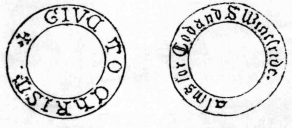MASS TIMES
CHRISTMAS MASS TIMES
Christmas Eve
December 24th
Carols 6:30pm
Vigil Mass 7:00pm
Midnight Mass
Christmas Day
December 25th
Mass 8:45am
Carols 10:15am
Mass 10:45am
Sunday: 6:30pm (Sat Vigil); 8:45am, 10:45am
Holy Days: 7:30pm (vigil), 9:00am, 7:30pm
Daily Mass: 10:00am (10am bank holidays)
except Friday term time:
9:10 am in school
Adoration of the Blessed Sacrament:
9:00 am weekdays
Morning Prayer:
9:40 am weekdays
Rosary:
after 10:00am weekday mass
Sacrament of Reconciliation: Saturdays
5:45pm -6:10pm
Little Church: during 10:45 mass, Sunday term times.
Newsletter: for our latest newsletter click here.
New Parishioners:
If you are new to our parish please call by or fill out a new registration from the Parish Office or download one from here.
The following account was researched and written in 1979 by Virginia Bowes with illustrations and rubbings by Bernadette and Naomi Bowes. In 1993 a book was written to celebrate 150 years of St Winefride’s, 1843 - 1993. This book contains some additional information and extracts are included in the priests section of the website.
Aspects of History
Historical Setting
St. Winefride's is one of the two oldest Roman Catholic churches in Wirral Peninsula; the other being St. Werburgh's, Birkenhead. They have in common ancient dedications and each is associated with a river and a ferry or a ford. The Benedictine monks of Birkenhead Priory (founded about 1150 by Hamon de Masci of Puddington) were confirmed forever in the right of ferry over the Mersey by Edward Ill's charter 1330, while the Township of Neston operated a regular ferry across the Dee to ports on the Welsh coast. As late as 1855 Slater's Directory for Cheshire recorded 'ferry boats pass regularly between Parkgate and Flint and Bagilt' whereas service to Ireland had been discontinued in the 1820s. Previous to this, coal from Denhall had been shipped regularly.
Doomsday Book records Great Neston as having two manors and the church dedicated to St. Mary and St. Helen and it is for this the town was 'Great.' The Town's importance continued so that in the reign of Edward I (1272 -1307) it was held directly of the King and played its part in Edward's preparations to invade Wales.
THE BELL-COTE AND PORCH c1979
Economic Strength
Neston's economic strength was considerable, derived mainly from coal -the seams of Denhall (also the name of one of the main gutters) being worked under the river bed. The growing demand for this commodity, the fisheries and port facilities, the availability of stone and clay for brickburning continued to make Neston one of the most densely populated towns in the peninsula. This prosperity was evident in the number of fine buildings of the late eighteenth and early nineteenth centuries, especially merchants' houses of which some remain in the area. For example the White House in Bridge Street (demolished 1976), Vine House and Moorside House in Parkgate Road; 4, 5, and 6, High Street built on sandstone outcrop, and Swan Cottage, Ness and the White House, Little Neston. Neston and Little Neston have also been noted for strongly built cottages and artisans' dwellings built in either stone or brick. Examples would include the four sandstone cottages near to the church dated 1848 and with the builder's initials DMC; the three sandstone cottages, 1732 and Hope Cottages, 1853 alongside the Green in Little Neston and sandstone cottages in Mill Street, Neston.
The district attracted workers (from Wales to work the coal-seams and from Ireland to find work in agriculture) but employment fluctuated and there were periods of great hardship for the less fortunate, and even for those in regular employment when sickness or accident or death occurred, so to guard against this hardship membership of a Friendly Society was essential. There were several, two being of special interest namely, The Court Stanley Lodge, of the Order of Foresters established in 1839 which held its meetings at the Brewers' Arms, and the Neston Female Friendly Society founded during the Napoleonic Wars and still holding its Ladies' Walk on the first Thursday in June. Two others were The Neston Independent Brotherly Society established about 1840 which met at the Nag's Head, and The Pride of Neston Lodge, belonging to the Ancient Order of Druids established in 1858, the meetings held at the Golden Lion.
That Neston should have one of the oldest Catholic churches in Wirral is not surprising therefore, adjacent as it is too, to Puddington Hall once the home of the Masseys, a leading recusant family in Cheshire and related to the Stanleys of Hooton. The last chaplain, Father Peter Baron, resided there for forty-two years and died on 26th November, 1893.
Dedication
St. Winefride became one of the patrons of the Shrewsbury Diocese on its formation in 1851. A number of considerations for the church's dedication to that saint must have been taken into account: to honour (St.) John Plessington's work in Puddington and district and, previous to this, at Holywell, an important Mission, and Neston was on the pilgrim route used even in Penal times; for the Dee may be forded at several points and Neston lies opposite to Flint en route for St. Winefride's shrine at Holywell; and in recognition of Pugin's close association with Wales. That the Earl of Shrewsbury was Pugin's patron and both were deeply involved in the Catholic revival provides another reason. There were also the geographic and commercial advantages Neston and Wales enjoyed. The dedication to St. Winefride renewed and strengthened the connection, and at a time when Roman Catholicism was being revived, with this ancient place (Holywell) of Christian worship.
On 23rd November 1851, Pope Pius IX granted a daily perpetual plenary indulgence to all who '…shall visit the church of St. Winefride, Holywell, and shall there devoutly pray for the advancement of the Holy Catholic church in England, and especially in the diocese of Shrewsbury' (The Tablet, Saturday, October 10th, 1857). St. Winefride is depicted as an abbess in the statue in the niche left of the Altar. The richly coloured East Window which was damaged and had to be removed in 1962, was dedicated to the Shrewsbury Diocese' patron saints namely, Our Lady Help of Christians and St. Winefride.
Foundation and Ownership of Land
Important to this church's foundation is the fact that in the nineteenth century the Earl of Shrewsbury owned approximately three fourths of the township of Little Neston. The plot containing 1 rood 30 perches was leased on 29th September, 1843 by John Earl of Shrewsbury, to Fr. Richard Gillow of Puddington, the Reverend Dr. Thomas Youens of Liverpool, Fr. William Turner and Fr. John Hall of Macclesfield at a rent of nineteen shillings for 99 years 'made payable by two equal half-yearly payments in each and every year of the said term on the twenty-fifth day of March and the twenty-ninth day of September. . ..' The lease contained a command to build a house on the land to cost not less than £150 'in a good and substantial manner with sound and good materials of every kind ... a house, outbuildings, commodities and conveniences ..'
On 31st December, 1861 the interest in the land (by which time a house, school and church had been erected) was assigned to Bishop Brown and five other priests as the trustees of the new Diocese of Shrewsbury. By then the freehold had passed under the will of the Earl of Shrewsbury who had died on August 10th, 1856 at Lisbon, to Lord Edmund Talbot, the second son of the Duke of Norfolk. Although the Lease was one for only 1 rood 30 perches, it would appear that in fact the trustees had been occupying no less than 1 acre 3 roods 17 perches. In 1897 the discrepancy is referred to in a conveyance under which in consideration of £330 conveyed the freehold of the original plot and also a further plot to the Bishop of Shrewsbury and trustees so the present plot still used became the absolute property of the Diocese.
In 1913 Lord Edmund Talbot made a gift of a triangular plot of land on the opposite side of Burton Road, it is believed with the object of an extension to the graveyard. After the Second World War it was thought this land might be used as a car park but the then Neston Urban District Council indicated that it would be regarded as a traffic hazard and eventually the land was sold.
The Architect: Church attributed to Pugin
Augustus Welby Northmore Pugin (1812 -1852) accepted a number of commissions from the Earl of Shrewsbury, one, if not the most important, of his patrons, and St. Winefride's is attributed to Pugin having been built (or converted from its original foundation as a school in 1840) during the period of his important work, 1836 -1844. The building appears to have some of the characteristics, and it is not unreasonable to suppose that the less important work would be influenced by the greater. Phoebe Stanton in her study of Pugin's work writes ‘These early Pugin churches could hardly have been less ostentatious, for they consisted of a nave without aisles, a chancel carefully expressed by a roof lower than that of the nave and a bell-cote placed either above the chancel arch or over the main door.... and in straitened circumstances Pugin was forced to be content with only narrow pointed windows.' He preferred to work in stone. The fine-grained red sandstone from Smallwood Quarry in Heswall was much sought after for building and used in the construction of St. Winefride's.
The original main building then is spare and sturdily built with an ark-like quality (in keeping with one who is reported as having said ‘There is nothing worth living for but Christian architecture and a boat' and embodies one of Pugin's two great rules for design 'that there should be no features about a building which are not necessary for convenience, construction, or propriety . ...’ By ignoring the chancel, Lady chapel and fittings it is easy to visualise the building as a school-room, and there is a link with this in the four benches immediately on the left on entering the church which are still called by the older parishioners the 'Children's Benches' with the Rector's Bench, raised, behind them. The porch is interesting in relation to this because there was once a door opposite the present outer door and this raises the question: Were there two doors providing separate entrances for boys and girls? Or was the blocked door the only entrance and could be observed from the 'teacher's cottage’? The present door might have been part of the alterations when the building became the parish church.
Blessing and Opening of the Church
According to Slaughter's Diocesan Records the church was opened on the feast of St. Winefride, 3rd November, 1843, though The Tablet dated Saturday, December 9th, 1843 records differently: 'St. Winefride's Chapel :- On Wednesday, the 29th ult, this Chapel was blessed and opened for public worship. The Holy Sacrifice of the Mass was offered, and a beautiful and appropriate sermon was preached on the interesting occasion, by the Rev. J. Maddocks, incumbent of St. Oswald's Church, near Liverpool. There was present besides the Rev. J. Kershaw, who is appointed to the new mission of Neston and Parkgate, the Revs. R. Gillow of Puddington; J. Tobin, Wrexham; W. Henderson, Birkenhead; Edward Carberry, Cheshire; J. Fleetwood, Liverpool; J. Wilding, St. Edward's College; and Mr. J. Milner of St. Cuthbert's College.'
This was obviously the occasion of the formal opening. It is worth noting and adds credence to the belief that St. Winefride's is Pugin's work, that St. Oswald's, Old Swan (now much altered) was built 1840- 1841, a chapel and school being added in 1844. In the same years the architect was supervising the building of St. John the Evangelist, Kirkham, and the Convent of the Sisters of Mercy, Liverpool (now demolished).
Alterations to the Buildings
In 1843 the small cottage attached to the school was enlarged by the addition of a kitchen and room over it, and in 1845 a vestry, coach house and loft were built and a well was sunk. The front of the house was again altered in 1854. Major alterations to the church were undertaken in 1852 on account of the increasing population. The Rector responsible was the Very Rev. James Canon Pemberton. Twenty-two feet were added to the length in two additional bays, the extreme bay forming the chancel. This was separated from the nave by a splayed arch and railing. Seating for more than another hundred people was thus gained. Later a small gallery was added for the choir. In 1858 'the interior was painted, and the chancel and chancel arch tastefully decorated .... Its adjacent new Gothic school and teacher's house was built in 1856. The whole group form a very pleasing and picturesque appearance, aided by its situation, overlooking the River Dee and the varied Welsh mountains.' (White's Cheshire Directory, 1860).
St. John Plessington's Vestment
The Windows/Stained Glass
There were numerous metal-work orders for this church placed by the Reverend Richard Gillow in 1841, and after the completion of the extension in 1852 and the decoration in 1858 the Reverend James Canon Pemberton turned his attention to the stained glass though the East Window may have already been positioned. The dating of one window that of St. Charles Borromeo with the dedication 'In pious memory of Charles Stanley of Denhall who died November 22nd, 1859' reveals a benefactor, as does the round window on the south side 'Praise the Lord Ye Children' naming 'Edward Barbara Charles and Mary Stanley.
Photo: Lodge, Chester
CHURCH INTERIOR AS IT WAS TO 1939
The dedication to St. Charles Borromeo (1538- 1584) Cardinal of the Church, could be that Charles Stanley was honouring his patron saint, one who worked tirelessly for the church's spiritual revival, and honouring too the work of priests and laymen who had and were still, labouring for Roman Catholic revival in this country.
The figure of the saint is dominant in attitude and colour
Charles Stanley, patron
Charles Stanley Massey, born 7th May 1787 (died 22nd November 1859), was the fourth son and the fifth child of Thomas Stanley Massey of Puddington and baptized in the Hall's chapel by the Rev. M. W. Blackoe. The family was a branch of the Stanley Massey - Stanleys of 'Hooton . . . which, ever since the reign of King Richard the Second, hath been the seat of the Stanleys of Hooton . . deriving their pedigree from Alan Silvester, upon whom Ranulph the first, Earl of Chester, bestowed the bailiwick cf the forest of Werral, and delivered unto him a horn, to be the token of his gift...’ The family originally assumed the surname Stanley 'from the lordship of Standleigh ... or Stanley, in Staffordshire ... so called from the nature of the soil, it being rough and stoney, with divers craggy rocks around it. . . ' The line has descended through Sir Rowland Errington - Stanley, Bart., of Ponsonby in Cumberland who has the possession of the Wirral Horn. Through his wife Barbara (one of their daughters was named for her and is buried with her father) Charles Stanley was connected with the Mostyn family. Both Charles Stanley of Denhall and Rowland Errington, Lord of the Manor of Ness, were coal-owners. They supported a school at Ness, where the Old School House remains.
The original metal work, the stained glass and the Stations of the Cross indicate the extent of Pugin's influence and the sensitive interpretation of this by craftsmen who acted on Pugin's second great rule for design 'that all ornament should consist of enrichment of the essential construction of the building.'
Stations of the Cross
The Stations of the Cross were added 1923 - 1925, the depth of colouring in the enamels complementing the stained glass. These enamels were executed at the end of the nineteenth century, or early twentieth and are derived, as far as shape and mood are concerned, from those in the workshop of Leonard Limosin at Limoges in the sixteenth century. Maison Bouasse Lebel Lecere & Co., Paris and Hardmans, Birmingham were the suppliers. Each station bears the name(s) of a donor many of whom or their families are buried in the churchyard. There were so many donations that some church decoration was carried out, it appears by Hardmans. Fr. John Ryan chose these Stations to enrich the church. The same priest carved in oak three stacking offertory plates, two of which are used, the one inscribed 'Alms for God and St. Winefride' regularly, and the smallest inscribed, 'Give to Christ' not so frequently. The third and largest has been lost.
He also carved the gates (recently removed) for the main entrance.
Consecration—9th August, 1939
The consecration of the church took place on 9th August 1939 and was continued on the 13th when His Lordship the Bishop of Shrewsbury, the Rt. Reverend A. J. Moriarty, D.D. sang Pontifical High Mass at the newly-consecrated altar. The marble altar, rails and pulpit were the work of Mr. E. Forrest Blackwell of Salford. The Rood Cross with Our Lady and St. John replaced the original sanctuary lamp, and the church lighting was modernised. Other changes included the paneling of the chancel walls. Those assisting at the ceremony were the Very Rev. Canon Tallon of Our Lady's, Birkenhead, the Rev. J. Donnelly, D.D. of St. John's, New Ferry and the Rev. J. Egan of the Salvatorial College, Christleton, Chester. The deacons at the throne were the Rev. H. R. Kelly, D.D. of St. Alban's, Macclesfield, and the Rev. G. Worsley, D.D. of St. Winefride's (parish priest). The Rev. E. Doyle of Shrewsbury, the Bishop's secretary was Master of Ceremonies, and the special preacher was the Rev. Joseph Howard, M.A. of Liverpool. In the evening Bishop Moriarty gave Pontifical Benediction, at which the Te Deum was sung in thanksgiving for the consecration.
The churchyard was laid out in 1851. One of its most striking features is the obelisk cross bearing the inscription :-
Bidston Observatory has records of very high winds and tides on that date. The Cross might well have replaced one erected in 1851.
Another interesting feature is the communal grave, plague pit of 1880 when an epidemic, probably cholera, broke out. It is the mound behind the Parish Hall. A part of the cemetery, the broad strip bordering the path to the left, was reserved for infant burial.
The graves of several priests, some former incumbents, are to be found: the Rev. James Canon Pemberton, 1891; the Rev. Joseph Canon Daly, 1891; the Rev. Peter E. Baron, Chaplain at Puddington 1893; the Rev. Francis L. Jones, 1966; the Rev. J. Devlin of Our Lady and St. John, Heswall, 1973; and the Rev. Canon Joseph M. Briscoe, a former parish priest and latterly of St. Hugh of Lincoln, Altrincham, 1978.
There is also the grave of the Servant of God, Theresa Helena Higginson (1844-1905) school teacher and mystic,
One other grave of special interest is that of Charles Stanley, already mentioned in this history, who died on 22nd November 1859, and whose grave bears the following coat of arms.
Aesthetically the area benefits from the trees surrounding the churchyard namely, the row of pines, and the copper beech, horse chestnut, sycamore, the young elm and the single oak, and the cedar in front of the church porch. All are subject to Tree Preservation Orders (1975). This is in keeping with the church which since 1971 has been classed Listed Building Grade II, because it is of 'special interest which warrants every effort being made to preserve it.'
Registers
The Registers date from 1843, over-lapping with those kept by the Chaplain at Puddington Hall. There is a record of the first Confirmation ceremony at St. Winefride's on the 24th November, 1845 by the Right Reverend James Brown, Vicar Apostolic for Lancaster and Chester, to become in 1851 the first Bishop of Shrewsbury.
Bell
The Bell, possibly the work of Mears & Stainbank, was rung regularly (certainly up to the outbreak of War in 1939) every Sunday morning to call the faithful to Mass.
The Parish grows with the district, the demands revealed in the three morning Masses and one in the evening, on Sunday, and variation in the times of Masses on Holydays which bear witness to the pressures of the twentieth century, far removed from the needs of the parish in 1852: 'Hours of service on Sunday and H.D. at 10 and 3' (Catholic Directory 1852).
The Missionary spirit that led to the building of this church continued for in 1919 Neston opened the mission that is now the parish of Our Lady and St. John, Heswall.
This history has presented aspects and serves as an introduction to a fuller work. I have tried to find an answer to some of the questions posed by the building and its foundation.
‘FOR GOD AND ST. WINEFRIDE’
Researched and written by Virginia Bowes.
Illustrations and rubbings by Bernadette and Naomi Bowes.
© Virginia Bowes, 1979
Select Bibliography Denis Gwynn: Lord Shrewsbury, Pugin and the Catholic Revival. Phoebe Stanton: Pugin. Nikolaus Pevsner and Edward Hubbard: The Buildings of England: Cheshire. George Ormerod: History of Cheshire. J. S. Howson and A. Rimmer: The River Dee: Its Aspect and History. T. Charles-Edwards: St. Winefride and Her Well. The Historical Background. Margaret Waugh: Blessed John Plessington. Cecil Kerr: Teresa Helena Higginson, School Teacher and Mystic. W. F. Irvine: Notes on the Old Halls of Wirral. Dorothy Sylvester: The Historical Atlas of Cheshire. Charles Creighton: A History of Epidemics in Britain (Volume 2). Howard Hodson: A History of Cheshire (Volume 9)— Restoration to Industrial Revolution. Catholic Directories, The Tablet (Upholland) and Documents from various sources.
|
Historical Gallery
Photos of St Winefride's pre-1939. You can click on any image thumbnail to expand it. If you have any photos you would like to share please contact the web manager.

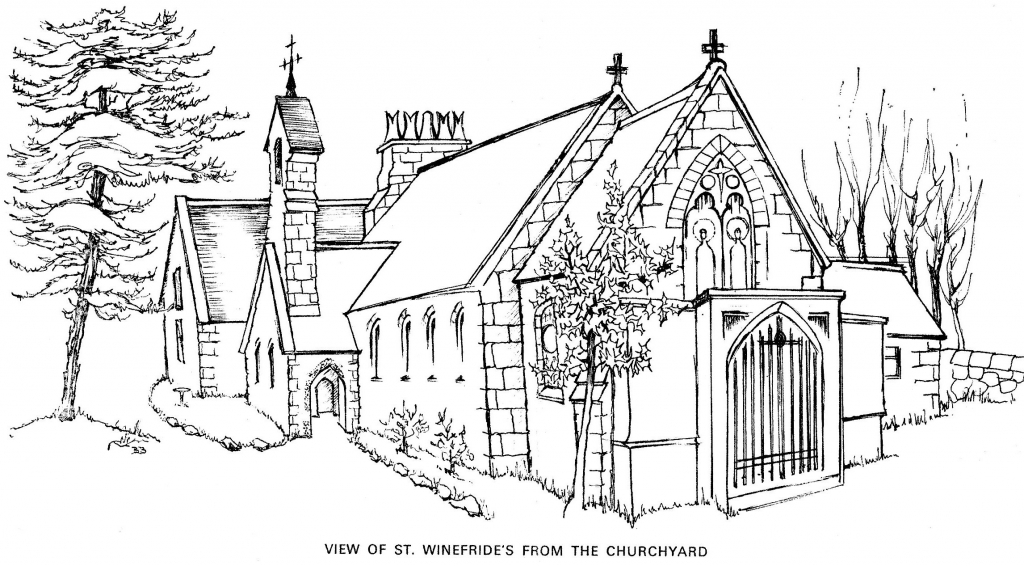
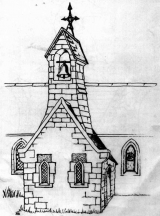
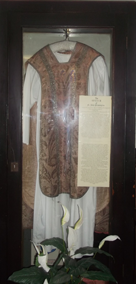 Over the years additions have been in keeping with the complex of buildings—in 1902 when the Parish Hall, the gift of Roger Taylor of Alma Cottage, Parkgate, was opened and in 1962 when Fr. Francis Jones (parish priest) had a chapel built behind the high altar, to receive the remains of St. John Plessington. (The exhumation at St. Nicholas' churchyard, Burton was disappointing). In each case stone was used, the tradition of the craftsman was continued - and Neston has a long history of craftsmanship of many kinds. The rose-coloured vestments heavily shot with silver which, it is believed, once belonged to this saint are preserved in the Church. Up to 1962 they were kept at St. Mary of the Angels, Hooton, but St. Winefride's was considered a more fitting depository since Neston was part of St. John Plessington's mission field. Connected with the tradition that this saint was buried in St. Nicholas' churchyard is the granite slab now beside the crypt which once covered the grave of Fr. Ralph Platt of Puddington (actively concerned in the founding of the Neston Mission) who died in 1837 and was buried in the grave of 'the other priest.'
Over the years additions have been in keeping with the complex of buildings—in 1902 when the Parish Hall, the gift of Roger Taylor of Alma Cottage, Parkgate, was opened and in 1962 when Fr. Francis Jones (parish priest) had a chapel built behind the high altar, to receive the remains of St. John Plessington. (The exhumation at St. Nicholas' churchyard, Burton was disappointing). In each case stone was used, the tradition of the craftsman was continued - and Neston has a long history of craftsmanship of many kinds. The rose-coloured vestments heavily shot with silver which, it is believed, once belonged to this saint are preserved in the Church. Up to 1962 they were kept at St. Mary of the Angels, Hooton, but St. Winefride's was considered a more fitting depository since Neston was part of St. John Plessington's mission field. Connected with the tradition that this saint was buried in St. Nicholas' churchyard is the granite slab now beside the crypt which once covered the grave of Fr. Ralph Platt of Puddington (actively concerned in the founding of the Neston Mission) who died in 1837 and was buried in the grave of 'the other priest.'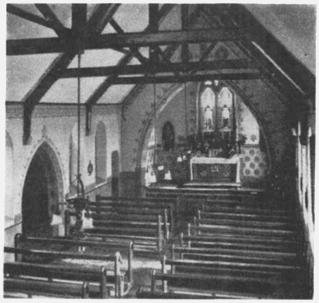
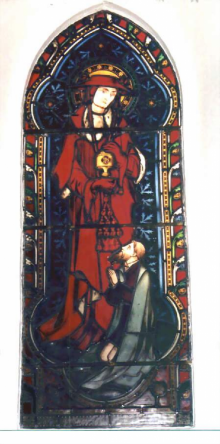 dwarfing the kneeling figure of the donor and complemented by the abstract pattern and the startlingly fresh green of the trefoil at his feet. The window beside it depicts the martyrdom of St. James. Opposite, in the south wall is one dedicated to St. Joseph. The fine detail includes the blue nimbus bordered with gold and a decorative border based on the natural forms so appreciated by Pugin, here being the Snowden Lily and the oak leaf. The figure is set against a richly patterned background off-set by the black and white chequered floor. One of two round windows depicts St. Anne holding a book for the Virgin leaning on her knee, the other 'Beloved Disciple' shows St. John supporting Our Lady after Calvary. In the south wall of the chancel is the round Pastor Bone window of the kneeling figure of Christ rescuing a lamb from among thorns. Of the East window only the tracery remains, two trefoil lights flanking a quatrefoil of the lamb with pennant. Originally there were two full-length figures, one of St. Winefride with the evidence of her martyrdom and healing, the other of Our Lady Help of Christians. The colours were especially rich-red, blue and gold - so that the window diffused a soft violet light.
dwarfing the kneeling figure of the donor and complemented by the abstract pattern and the startlingly fresh green of the trefoil at his feet. The window beside it depicts the martyrdom of St. James. Opposite, in the south wall is one dedicated to St. Joseph. The fine detail includes the blue nimbus bordered with gold and a decorative border based on the natural forms so appreciated by Pugin, here being the Snowden Lily and the oak leaf. The figure is set against a richly patterned background off-set by the black and white chequered floor. One of two round windows depicts St. Anne holding a book for the Virgin leaning on her knee, the other 'Beloved Disciple' shows St. John supporting Our Lady after Calvary. In the south wall of the chancel is the round Pastor Bone window of the kneeling figure of Christ rescuing a lamb from among thorns. Of the East window only the tracery remains, two trefoil lights flanking a quatrefoil of the lamb with pennant. Originally there were two full-length figures, one of St. Winefride with the evidence of her martyrdom and healing, the other of Our Lady Help of Christians. The colours were especially rich-red, blue and gold - so that the window diffused a soft violet light.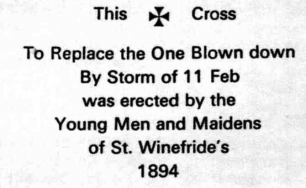
 whose sister, Louisa was headmistress of St. Winefride's school and with whom she frequently stayed.
whose sister, Louisa was headmistress of St. Winefride's school and with whom she frequently stayed.